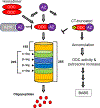Bachmann-Bupp syndrome and treatment
- PMID: 37469105
- PMCID: PMC10796844
- DOI: 10.1111/dmcn.15687
Bachmann-Bupp syndrome and treatment
Abstract
Bachmann-Bupp syndrome (BABS) is a neurodevelopmental disorder characterized by developmental delay, hypotonia, and varying forms of non-congenital alopecia. The condition is caused by 3'-end mutations of the ornithine decarboxylase 1 (ODC1) gene, which produce carboxy (C)-terminally truncated variants of ODC, a pyridoxal 5'-phosphate-dependent enzyme. C-terminal truncation of ODC prevents its ubiquitin-independent proteasomal degradation and leads to cellular accumulation of ODC enzyme that remains catalytically active. ODC is the first rate-limiting enzyme that converts ornithine to putrescine in the polyamine pathway. Polyamines (putrescine, spermidine, spermine) are aliphatic molecules found in all forms of life and are important during embryogenesis, organogenesis, and tumorigenesis. BABS is an ultra-rare condition with few reported cases, but it serves as a convincing example for drug repurposing therapy. α-Difluoromethylornithine (DFMO, also known as eflornithine) is an ODC inhibitor with a strong safety profile in pediatric use for neuroblastoma and other cancers as well as West African sleeping sickness (trypanosomiasis). Patients with BABS have been treated with DFMO and have shown improvement in hair growth, muscle tone, and development.
© 2023 The Authors. Developmental Medicine & Child Neurology published by John Wiley & Sons Ltd on behalf of Mac Keith Press.
Conflict of interest statement
CONFLICT OF INTEREST STATEMENT
ASB and CPB are listed inventors of a US patent based on the method of treating or preventing developmental disorders associated with mutations in the
Figures



Similar articles
-
Biochemical features of primary cells from a pediatric patient with a gain-of-function ODC1 genetic mutation.Biochem J. 2019 Jul 24;476(14):2047-2057. doi: 10.1042/BCJ20190294. Biochem J. 2019. PMID: 31249027
-
Monitoring ODC activity and polyamines in Bachmann-Bupp syndrome patient biological samples.Methods Enzymol. 2025;715:257-270. doi: 10.1016/bs.mie.2025.01.071. Epub 2025 Feb 26. Methods Enzymol. 2025. PMID: 40382142
-
Estradiol control of ornithine decarboxylase mRNA, enzyme activity, and polyamine levels in MCF-7 breast cancer cells: therapeutic implications.Breast Cancer Res Treat. 1994 Feb;29(2):189-201. doi: 10.1007/BF00665680. Breast Cancer Res Treat. 1994. PMID: 8012036
-
Bachmann-Bupp Syndrome.2022 Aug 25. In: Adam MP, Feldman J, Mirzaa GM, Pagon RA, Wallace SE, Amemiya A, editors. GeneReviews® [Internet]. Seattle (WA): University of Washington, Seattle; 1993–2025. 2022 Aug 25. In: Adam MP, Feldman J, Mirzaa GM, Pagon RA, Wallace SE, Amemiya A, editors. GeneReviews® [Internet]. Seattle (WA): University of Washington, Seattle; 1993–2025. PMID: 36007106 Free Books & Documents. Review.
-
Polyamine Metabolism for Drug Intervention in Trypanosomatids.Pathogens. 2024 Jan 16;13(1):79. doi: 10.3390/pathogens13010079. Pathogens. 2024. PMID: 38251386 Free PMC article. Review.
Cited by
-
Design, Synthesis, and Biological Activity of Novel Ornithine Decarboxylase (ODC) Inhibitors.J Med Chem. 2025 Mar 13;68(5):5760-5773. doi: 10.1021/acs.jmedchem.4c03120. Epub 2025 Mar 4. J Med Chem. 2025. PMID: 40035393 Free PMC article.
-
Polyamines buffer labile iron to suppress ferroptosis.bioRxiv [Preprint]. 2025 Jul 2:2025.06.30.662349. doi: 10.1101/2025.06.30.662349. bioRxiv. 2025. PMID: 40631118 Free PMC article. Preprint.
-
Molecular basis of TRPV3 channel blockade by intracellular polyamines.Commun Biol. 2025 May 10;8(1):727. doi: 10.1038/s42003-025-08103-x. Commun Biol. 2025. PMID: 40348873 Free PMC article.
-
Biogenic Amine Metabolism and Its Genetic Variations in Autism Spectrum Disorder: A Comprehensive Overview.Biomolecules. 2025 Apr 7;15(4):539. doi: 10.3390/biom15040539. Biomolecules. 2025. PMID: 40305279 Free PMC article. Review.
-
Repurposing With Purpose: Treatment of Bachmann-Bupp Syndrome With Eflornithine and Implications for Other Polyaminopathies.Am J Med Genet C Semin Med Genet. 2025 Apr 1:e32138. doi: 10.1002/ajmg.c.32138. Online ahead of print. Am J Med Genet C Semin Med Genet. 2025. PMID: 40167220
References
-
- Snyder RD, Robinson A. Recessive sex-linked mental retardation in the absence of other recognizable abnormalities. Report of a family. Clin Pediatr (Phila) 1969; 8: 669–74. - PubMed
-
- Cason AL, Ikeguchi Y, Skinner C, Wood TC, Holden KR, Lubs HA, Martinez F, Simensen RJ, Stevenson RE, Pegg AE, Schwartz CE. X-linked spermine synthase gene (SMS) defect: the first polyamine deficiency syndrome. Eur J Hum Genet 2003; 11: 937–44. - PubMed
-
- Bupp CP, Schultz CR, Uhl KL, Rajasekaran S, Bachmann AS. Novel de novo pathogenic variant in the ODC1 gene in a girl with developmental delay, alopecia, and dysmorphic features. Am J Med Genet A 2018; 176: 2548–53. - PubMed
-
- Bachmann AS, Fernandez-Lopez J, Ginsburg S, Thomas H, Bouwkamp JC, Solomos T, Matile P. Stay-green genotypes of Phaseolus vulgaris L.: chloroplast proteins and chlorophyll catabolites during foliar senescence. New Phytol 1994; 126: 593–600.
-
- Bachmann AS, Matile P, Slusarenko AJ. Inhibition of ornithine decarboxylase activity by phaseolotoxin: Implications for symptom production in halo blight of French bean. Physiol Mol Plant Pathol 1998; 53: 287–99.
Publication types
MeSH terms
Substances
Grants and funding
LinkOut - more resources
Full Text Sources
Research Materials

